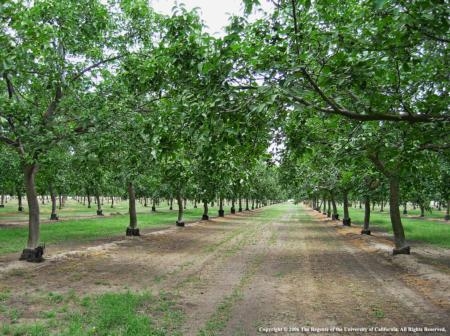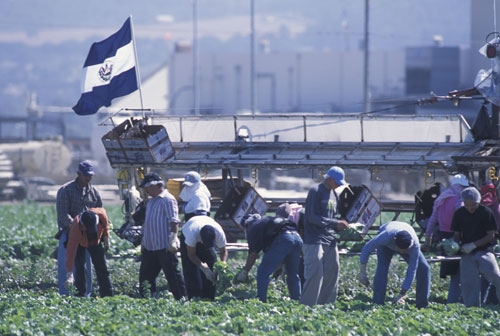UC Blogs
UC research predicts climate change effects in California
The report, the third such assessment since 2006, provides new data to help Californians plan and adapt to climate change.
"Significant increases in wildfires, floods, severe storms, drought and heat waves are clear evidence that climate change is happening now. California is stepping up to lead the way in preparing for — and adapting to — this change," said state Secretary for Natural Resources John Laird. "These reports use cutting-edge science to provide an analytical roadmap, pointing the way for taking concrete steps to protect our natural resources and all Californians."
A study led by Louise Jackson, UC Cooperative Extension specialist in the Department of Plant Sciences at UC Davis, took an inventory of greenhouse gas emissions on Yolo County farmland and studied how agriculture can adapt to climate change.
An op-ed co-authored by Richard Rominger, a farmer and member of the UC President’s Advisory Commission on Agriculture and Natural Resources, and published in the Sacramento Bee noted the study “found that urban land accounts for 70 times more greenhouse gas emissions per acre than cropland.” A good reason to protect cropland.
The website based on the Jackson study provides a tool for Yolo County farmers and policymakers to plan for the changes that occur at the regional level with climate change.
For planning on a larger scale, a coalition of scientists and state agencies has developed Cal-adapt, a web-based climate adaptation planning tool. Cal-adapt allows users to identify potential climate change risks in specific geographic areas throughout the state. Users can query by location or click on an interactive map to explore what climate impacts are projected to occur in different regions of the state.
“Climate change is expected to affect the quantity and timing of water flow in the state,” explained Kaveh Madani, a former postdoctoral research scholar in UC Riverside’s Water Science and Policy Center, who led a research project on climate change effects on hydropower production, demand, and pricing in California.
“If California loses snowpack under climate warming, these high-elevation reservoirs might not be able to store enough water for hydropower generation in summer months when the demand is much higher and hydropower is priced higher,” said Madani, currently an assistant professor of civil, environmental, and construction engineering at the University of Central Florida. “California might, therefore, lose hydropower in warmer months and hydropower operators may lose considerable revenues.”
Max Moritz, UC Cooperative Extension specialist in the Department of Environmental Science, Policy and Management at UC Berkeley, contributed a paper to the extensive report about increased vulnerability to wildland fires in the state.
“The incredible breadth of studies, as well as the depth of their analyses, reveals just how much the University of California has to offer in preparing us all to adapt to a changing climate,” Moritz said of the full report.
Read more on specific campus researchers' contributions to the report in these news releases:
- UC Berkeley: State taps UC researchers for expertise on climate change impacts
- UC Davis: Scientists examine California's vulnerability to climate change
- UC Merced: More homes in danger from fire in coming decades
- UC Riverside: California’s hydroelectricity production is vulnerable to climate change
- Scripps: More hot Julys, rises in sea level three feet or more forecast
For highlights of the reports in Our Changing Climate, see the California Energy Commission’s press release. The full reports can be downloaded from the CEC’s website.
California farmers fear labor shortage, but experts are skeptical
Farmers say traversing the Mexico-U.S. border has become more difficult for would-be farmworkers, causing a labor shortage in California, according to an article in the San Jose Mercury-News.
"(Border crossing) is more dangerous because of the drug cartels, our government is doing a better job of enforcing the borders and the Mexican economy is doing better," said Jim Lincoln, a vintner and former president of the Napa County Farm Bureau.
Phil Martin, professor in the Department of Agricultural and Resource Economics at UC Davis, paints a different picture. He estimates the yearly number of farm laborers has remained steady in the last decade at around 800,000 people after it had expanded in the 1990s.
Martin is skeptical of perennial farmworker shortage warnings, finding no signs of diminished crops or fewer workers in a 2007 report, but five years later he says the farming community has hit "a period of uncertainty."
Waiting to Bloom
So the other day we were in the San Francisco for lunch and a walk around. As we were leaving the Embarcadero there was this little flower shop that had a few potted plants outside. Well you know that no Master Gardener can walk past a stand of plants or vegetation without at least taking a 5 minute look-see.
I walked inside first. The tiny cramped shop was humid and there were canaries in cages singing away. The cut flowers were beautiful. From the ordinary daisy to exotic orchids. There were a lot of flowers crammed into this dark little place.
I stepped back out into the sunlight to peruse the potted plants, thinking I could take home a living souvenir from our day. Well, the frugal part of Master Gardener caught up with me- $8.50 for a polka dot plant in a 4 inch pot! I just picked one up for a filler at Walmart for $2.50.
Then there was a row of African Violets. But wait, these had a tag hanging over them. “Waiting to Bloom--$4.50”. They honestly didn’t look much different than the others that were bloomed. There was also a succulent in a 4” pot for $8.99 that while healthy, was still only half the size of one at a local garden center.
At this point, I finally had had enough of searching for my living souvenir and decided to head on my way with just some photos. Just as I ran out of room on my photo card, I looked down and at my feet was a large group of chopped-off orchids. There were two leaves and a piece of stem. I now know where all those pretty cut ones inside had come from. The sign read Phalaenopsis $3.00…Waiting to Bloom.
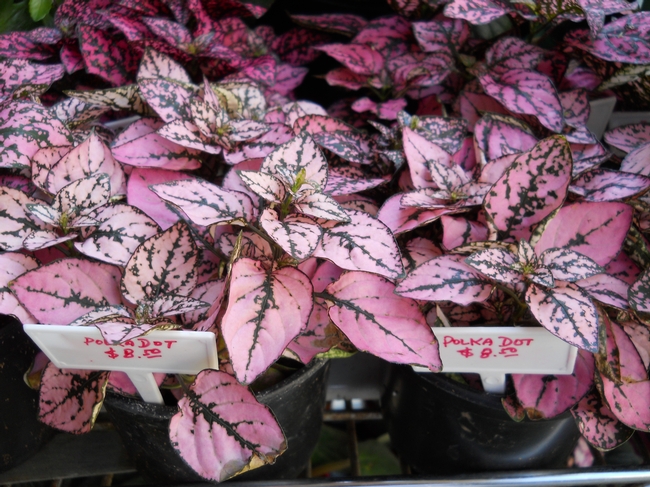
Pricey polka dot plant. (photos by Patricia Brantley)

Tag on African violet.
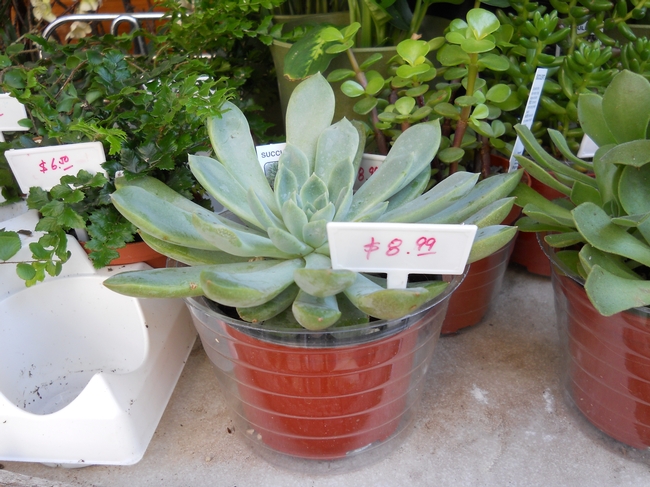
Expensive succulent.
Home Sweet Home
It's good to see county and state fairs focusing on bugs 'n bees. These displays inform, educate and entertain. The California State Fair,...
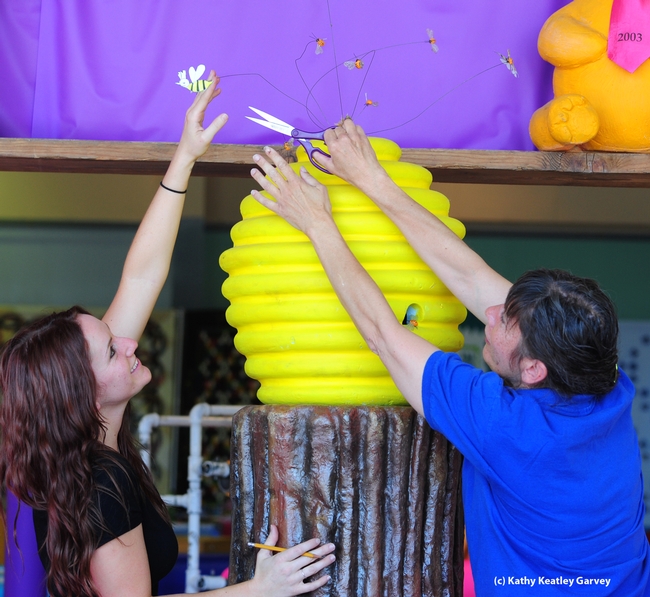
Elisa Seppa (left), superintendent of McCormack Hall, Solano County Fair and assistant superintendent Gloria Gonzalez work on a skep display. (Photo by Kathy Keatley Garvey)
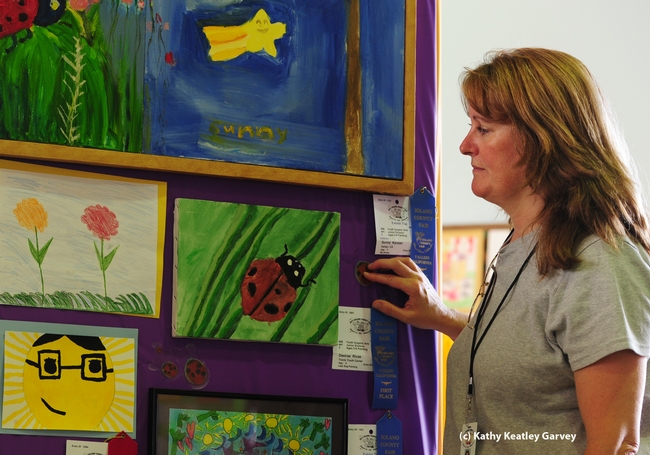
McCormack Hall assistant Deborah Miller of Vallejo just finished installing this display, which includes colorful ladybugs. (Photo by Kathy Keatley Garvey)
Grape Turtles
The crape myrtles are blooming. Have you noticed? They’re pretty hard to miss, what with their beautiful blossoms in hot fuchsia, spicy red, pale lavender, pretty pink and clear white. These woody perennials thrive in Solano’s zones and offer year-round interest: peeling bark in winter and spring, blooms in summer, and fall leaf color.
I just stumbled across something I’d not realized about Lagerstroemia, the genus also known as crape myrtle. Not everyone spells it like that: CRAPE myrtle. Many spell it CREPE myrtle. Apparently, this is a long-running horticultural debate. Whether it’s spelled crape myrtle, crepe myrtle, crapemyrtle, crepemyrtle or crepe myrtles may simply be a geographical preference, or an evolution of language. In the U.S., the traditional Southern spelling is crepe myrtle (because the delicate flowers resemble crepe paper). Across the rest of the U.S. it is more commonly spelled crape myrtle, which is considered the French spelling. In Europe and Australia and other countries they use the scientific name, Lagerstroemia Crape Myrtle.
But I think my youngest child, Katie, has the best name for the shrubby little trees. As young as first grade, Katie noticed when Vacaville’s crape myrtles started to bloom. Knowing I love the beautiful colors, Katie would point them out: “Look, Mommy! The grape turtles are blooming!” Katie’s nearly 18 now and we still giggle when we notice summer’s explosion of crape myrtle blossoms.
Grape turtles indeed.
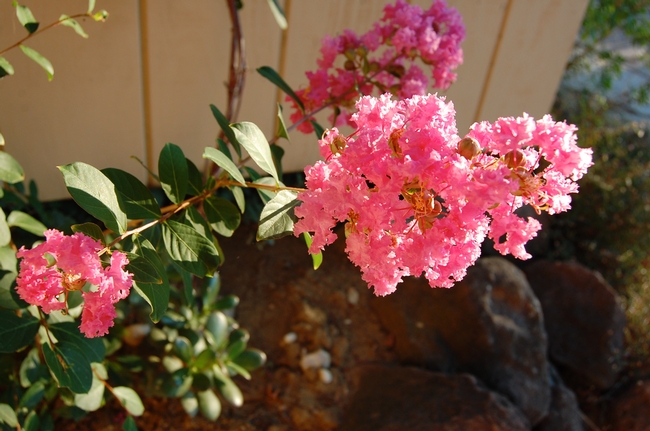
You say crape myrtle, I say grape turtle: Summer in Solano means the Lagerstroemia are in bloom. (photo by Kathy Thomas-Rico)


